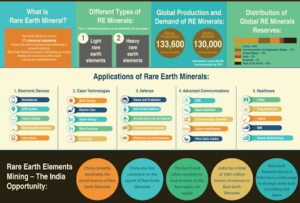In news- Recently, a bill was introduced in the US Senate that would force its defence contractors to stop buying rare earths metals from China by 2026 and use the Pentagon to create a permanent stockpile of the strategic minerals.
About Rare earth metals-
- The rare-earth elements (REE), also called the rare-earth metals or rare-earth oxides, or the lanthanides are a set of 17 nearly-indistinguishable lustrous silvery-white soft heavy metals.
- Rare earths have diverse applications in electrical (electric vehicles) and electronic components, lasers, weaponry, glass, magnetic materials, and industrial processes.
- They do not occur as base metals or in lump or visible quantities like iron or aluminum, and hence their names and properties are unfamiliar in everyday life.

- The first rare-earth mineral discovered (1787) was gadolinite, a black mineral composed of cerium, yttrium, iron, silicon, and other elements.
- This mineral was extracted from a mine in the village of Ytterby in Sweden; four of the rare-earth elements bear names derived from this single location.
- The content of the individual rare-earth elements varies considerably from mineral to mineral and from deposit to deposit.
- REEs are categorized as being either “light” or “heavy”:
- Light REEs (lanthanum, cerium, praseodymium, neodymium, promethium, samarium, europium, gadolinium and scandium) are produced in global abundance and are in surplus supply.
- Heavy REEs (terbium, dysprosium, holmium, erbium, thulium, ytterbium, lutetium and yttrium) are produced mainly in China and are in limited supply. Global efforts to bring new resources to the marketplace continue.
- They, when looked at anatomically, seem to be inseparable from each other, in that they are all almost exactly the same in terms of their chemical properties.
- However, in terms of their electronic properties, their magnetic properties, each one is really exquisitely unique.
- The most abundant rare-earth element is cerium, which is actually the 25th most abundant element in Earth’s crust, having 68 parts per million (about as common as copper).
- The exception is the highly unstable and radioactive promethium “rare earth” is quite scarce.
- The longest-lived isotope of promethium has a half-life of 17.7 years, so the element exists in nature in only negligible amounts (approximately 572 g in the entire Earth’s crust).
- Promethium is one of the two elements that do not have stable (non-radioactive) isotopes and are followed by (i.e. with higher atomic number) stable elements (the other being technetium).
Rare earth metals in India and the world-
- China today controls nearly 90% of global rare earth production. About 94 percent of the rare earths mined in China are from bastnasite deposits
- The United States has only one rare earths mine and has no capability to process rare earth minerals. It stands second in terms of production. It is followed by Myanmar, Australia.
- India has the world’s fifth-largest reserves of rare earth elements, but it imports most of its rare earth needs in finished form from China.

















